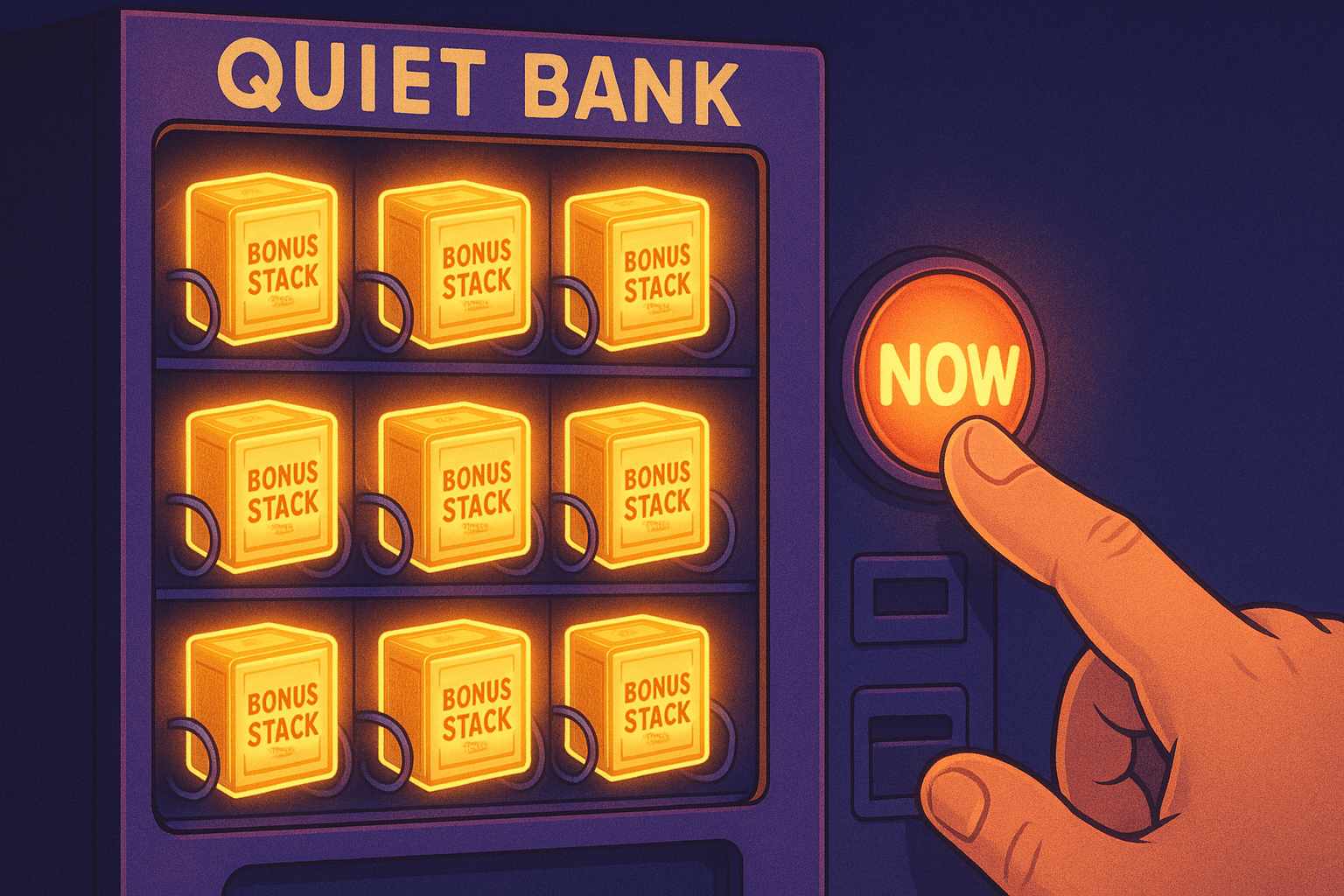9 Quiet Bank Bonus Stacks for {state} Savers
9 Quiet Bank Bonus Stacks for Real Cash Now

Last Updated:
(Quiet Gains)
In {state}, smart savers can quietly layer bank incentives—welcome bonuses, referrals, and activity credits—into real dollars without chasing hype or risking fees; here are the nine stacks seasoned bonus hunters use to turn everyday banking into cash while staying well within the rules.
1. Pair a Checking Bonus with True Direct Deposit
Open a new checking account offering a cash bonus for qualifying direct deposits, then route at least one payroll to satisfy terms and avoid monthly charges. The stack comes from timing: complete the deposit requirement early, then keep modest activity going to snag debit cash‑back or bill‑pay credits many banks auto‑activate in the first 60–90 days.
Compliance keys: confirm what the bank counts as “direct deposit,” keep the account fee‑free with minimum balance or activity, and note that bonuses are typically reported as interest.
See If Your Auto Insurance Is Leaving Money on the Table
Car coverage is required, but many drivers in {state} quietly overspend because they never re‑shop after life changes.
Use {offer_name} to compare live rates side by side without phone spam, then lock in a lower premium in minutes; you can see your options now and decide when to switch.
In {state}, drivers often qualify for extra savings when they drive fewer miles, bundle, or add a safe‑driver program.
Pro move: run a fresh comparison on {offer_name} at renewal and after any address or mileage change to capture new discounts.
2. Referral Chains at Credit Unions and Community Banks
Many local institutions pay both referrer and referee. Join via an easy membership route, score the new‑member bonus, then refer a spouse or family member to multiply payouts. Track annual caps, stagger openings by calendar quarter, and keep each account in good standing to stay eligible for future promos.
What to watch: referral limits per year, minimum balance requirements, and whether the referrer must maintain an open account until payout clears.
3. Double Dip Bank plus Brokerage Under One Brand
Households can open a checking for a cash bonus and separately transfer assets to the affiliated brokerage for a second bonus. Relationship tiers may unlock higher checking rewards while you wait for the brokerage bonus to vest.
Guardrails: asset‑transfer clocks often run 60–90 days, early withdrawals claw back bonuses, and interest/tax reporting differs by account type.
4. Bill Pay, Zelle, and Card Activation Milestones
Some banks quietly attach micro‑bonuses to first‑time actions: schedule a few bill pays, send a person‑to‑person payment, enroll in e‑statements, or activate a debit card to trigger $5–$25 credits. Batch them within the promotional window after opening to stack small wins on top of the main bonus.
Read the fine print: caps per action, cut‑off dates, and eligible payees can apply.
5. New‑Money Savings Boosts plus Welcome Cash
Open a savings account that pays a “new money” growth bonus alongside a checking welcome offer from the same bank. Move funds in a single transfer to qualify for the savings boost, then park the balance only as long as the terms require before redeploying to a higher yield if needed.
Mind the dates: measurement periods for “net new” balances often span statement cycles; calendar them so you do not drop below thresholds prematurely.
6. Small‑Business Checking plus Personal Checking
If you have a side hustle, sole‑prop, or LLC, open a business checking for a sizable bonus and a personal checking for a second payout. Because these are distinct products, the bonuses usually do not conflict, allowing two checks for one banking relationship.
Keep it clean: use separate tax IDs when required, maintain minimum activity, and avoid cash‑intensive patterns that trigger reviews.
7. Student and Teen Accounts with Parent Referral
Many banks court younger customers with $50–$200 promos and fee‑free terms; parents can refer teens or students to stack a referral bonus plus the youth account reward. Set up small recurring deposits and a couple of supervised transactions to meet activity rules without overspending.
Tip: schedule an automatic savings transfer to reinforce good habits while meeting monthly activity triggers.
8. Activity Calendars for Seasonal and Targeted Offers
Banks roll out the richest public bonuses around tax time and year‑end, while targeted mailers may land mid‑quarter. Track both on a simple calendar. When you receive a targeted code, ask a banker to apply the highest available offer and confirm in writing which code is active before funding.
Avoid conflicts: never stack two promo codes for the same product unless terms explicitly allow it, and screenshot the offer details with dates.
9. Debit Cash‑Back, Round‑Ups, and Merchant Credits
Neobanks and regional players offer opt‑in debit cash‑back, category boosts for groceries or transit, and round‑up matches for a few months after opening. Switch on every available toggle in the app and route a handful of planned purchases to harvest easy credits without chasing spend.
Exit plan: after the promo window ends, keep only no‑fee accounts or downgrade tiers to avoid maintenance charges; most bonuses are interest for tax purposes.
Auto Insurance: Cut Your Premium Before Your Next Bill
Many households in {state} find instant savings just by checking modern pricing instead of letting policies auto‑renew.
Start with {offer_name}, a quick comparison tool that surfaces top carriers side by side; you can check your rate in under a minute and see which discounts you qualify for today.
In {state}, low‑mileage and safe‑driver programs can stack with bundling for outsized price drops.
Lock it in: revisit {offer_name} any time your commute, vehicle, or address changes to keep your premium aligned with your real risk.
Here's How You Do It
Step 1:
Type your ZIP code into the checker and see discounted rates instantly.
Step 2:
Answer a few driving questions, then compare quotes from leading companies on {offer_name} and choose the best deal.

